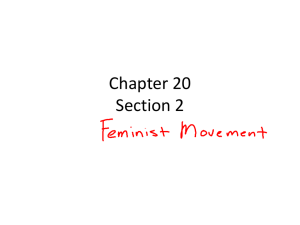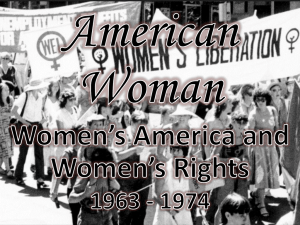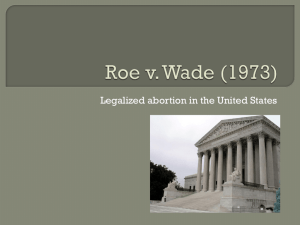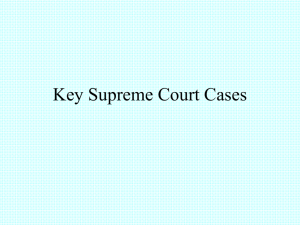Why did people oppose Women*s Liberation?
advertisement
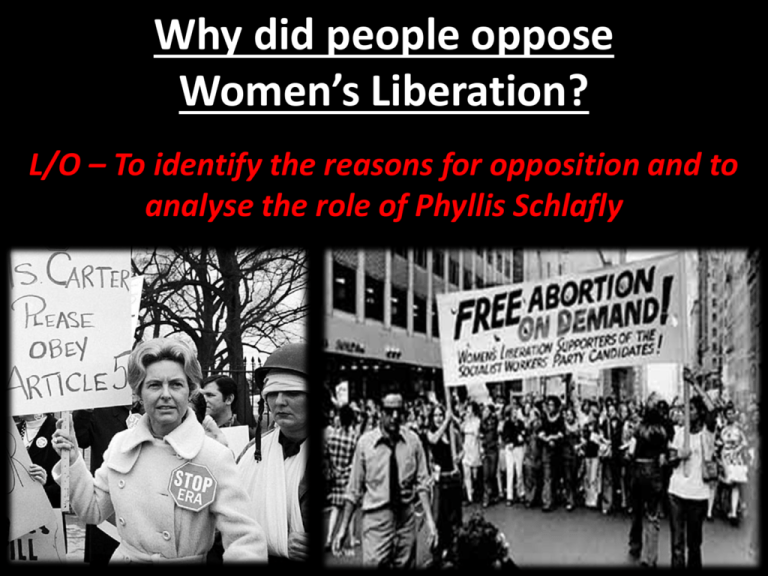
Why did people oppose Women’s Liberation? L/O – To identify the reasons for opposition and to analyse the role of Phyllis Schlafly Reasons for Opposition • • Some opponents wanted women to stick to the role of homemaker. As late as 1970, The women’s liberation new organisations such as movement faced opposition Happiness of Womanhood from men AND women. were being formed to support the role of woman as homemaker. Others thought Some people rejected to that women should be everything the movement putting their energy into stood for. Others objected only other movements (those to some of the changes the against poverty or racism, for movement pushed for. example) • One of the biggest issues that divided people was abortion. Source A: From a modern textbook. Abortion • In 1960 abortion was illegal in the USA, although some states allowed it if the mother’s life was at risk. • Illegal abortions were dangerous and many women died during procedures. • Unwanted pregnancy was too often seen as a problem for the pregnant woman to solve. Abortion • Groups like NOW campaigned for the right to abortion, because it was a woman’s body and life that were affect by the pregnancy. • The issue soon became a struggle between the rights of the woman vs. the rights of the unborn child. Abortion • From 1965 onwards, some states brought in laws that allowed abortions for more reasons than just saving a mother’s life. • Then in 1973, the case of Roe v. Wade was taken to the Supreme Court fighting for a woman’s right to have an abortion. Abortion • The decision was that for the first 12 weeks, a woman now had the right to choose an abortion, in any state. • The the next 12 weeks, the state could allow abortion depending on individual cases. • For the last 12 weeks the mothers life had to be at risk. • Abortion was now legal but anti-abortion groups did not give up the fight to stop it. Effects of Legalised Abortion There is much debate about some of the effects but it is clear that: 1. Abortions became safer – Before 1973, over 23% of all pregnancy complications brought to hospital were because of attempted abortions. The rate is now 1%. 2. The rift between people in favour of allowing abortion and those against it grew deeper. 3. Some argue it caused the crime rate to drop The Equal Rights Bill (ERA) • Every year since 1923, Congress was asked to consider passing an Equal Rights Amendment Bill – its aim was to amend the constitution to stop discrimination against a person because of their sex. • The bill rarely reached Congress because opponents managed to stop it at the committee stage. The Equal Rights Bill (ERA) • In 1972, thanks to the work of NOW and other women’s liberation groups, politicians realised that enough women supported ERA to affect voting results. • Holding ERA up might lose them votes. The Bill was passed by the House of Representatives and the Senate. So Congress had passed the amendment. It just had to be ratified by at least 38 states by 1980 to become law. Phyllis Schlafly • By 1972, 30 states had ratified ERA. Then Phyllis Schlafly set up STOP (Stop Taking Our Privileges) to campaign against ERA. • Schlafly was a married lawyer who had once run for Congress in 1952. She opposed women’s lib as damaging to family values. • In 1967 she set up the Eagle Forum, a conservative, pro-family group. This became STOP in 1972. Phyllis Schlafly • Schlafly argued against ERA because she said it would remove privileges that many women wanted (e.g. exemption from conscription to the army) • She also argued that many poorer women who wanted to be wives and mothers would be disadvantaged by the amendment. • Her campaign convinced states that there was considerable opposition to ERA as well. Only 30 ratified the amendment. It was not passed. Summary – Why did women oppose the women’s movement? 1. Some believed that NOW was dominated by white, middle-class females that working class women couldn’t relate to. 2. Others objected to the extreme demands and methods of the women’s lib movement. 3. A number genuinely believed in and accepted the traditional role of women. 4. Some women were anti-abortion. 5. Movement did not seem to be doing enough to help poor women. Exam Question • ‘Use the source and your own knowledge to explain why opposition to the women’s liberation movement grew in the early 1970’s’ (10 marks) The Source Underline key words, events, and people in the source that you can write more about First Reason Give the first factor mentioned in the source. Fully explain it. Link Make a link with the 2nd factor Second Reason Fully explain the second factor Conclusion Sum up the two factors, stressing the links between them Some opponents like Phyllis Schlafly wanted women to stick to the role of homemaker. As late as 1970, new organisations such as Happiness of Womanhood and STOP were being formed to support the role of woman as homemaker. Others thought that women should be putting their energy into other movements (those against poverty or racism, for example) rather than just campaigning on ERA and abortion. Source A: From a modern textbook.
